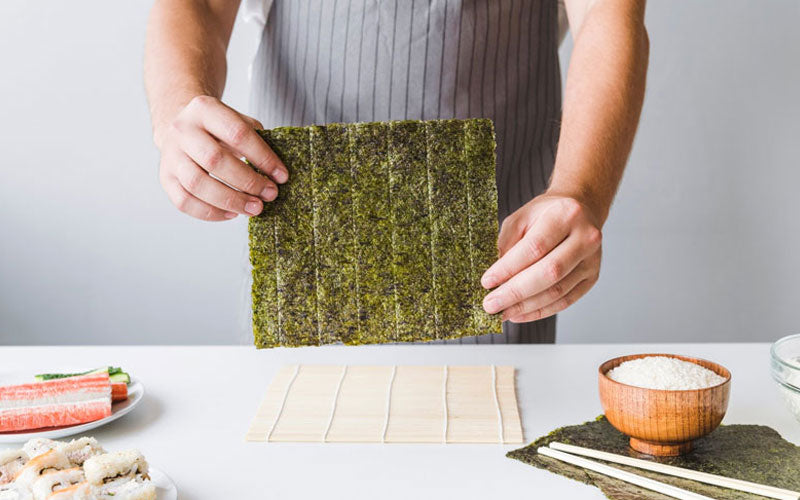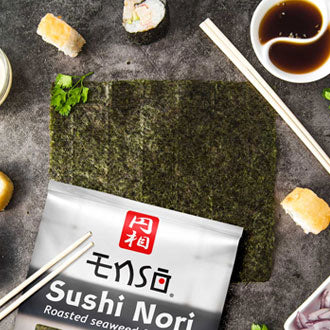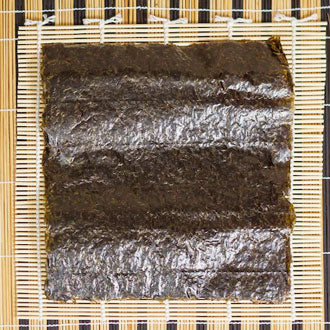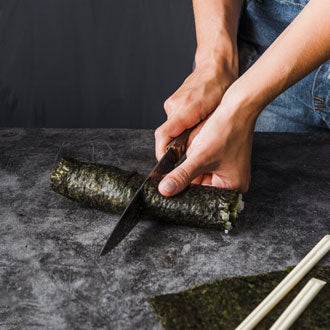8 Ways to use Nori seaweed

If you’re familiar with Japanese cuisine, you’ve probably had Nori seaweed before. Nori is a dried edible seaweed and is usually presented in a deep green sheet. It is probably best known as the wrapping used for sushi rolls or onigiri (rice balls), but this tasty ingredient can also add a layer of toasty umami to many other dishes.
In this article, we’ll show you a variety way to add Nori in your cooking.
Nori seaweed is popular all over Japan and a fundamental element of Japanese cuisine. Nori has been consumed in Japan for many centuries and is included in a wide variety of meals. It is very versatile, you can use it to wrap sushi, eat it with rice, soup or as a snack.
There are many types of edible seaweed around the world, but Japanese Nori is unique because the process of making it is similar to papermaking.
Before the Edo period, Nori was mainly eaten as a paste. However, Japanese people discovered a better way to eat it during the Edo period, sushi also increased in popularity during this time. The people of that era made it into a thin sheet. This is also why many types of sushi contain Nori.
How Nori seaweed is made?

After harvesting from the sea, Nori seaweed is minced and blended into small pieces to create a mixture. A production facility is used to clean Nori seaweed and produce a mixture. The mixture is poured into molds and fan-dried and pressed to move through a drying machine.
After that Nori sheets are loaded into a roasting machine and passed through an oven to kill bacteria as the final step in production. Nowadays, Nori seaweed is dried and packaged and can be bought by anyone anywhere.
Is Nori good for you?

Adding seaweed to your meal not only enhances its flavor, texture, and nutritional value, but it is also an easy way to increase your intake of vitamins and minerals.
Nori is very low in calories, but high in vitamins and minerals including vitamin A, K, C and B, as well as calcium, magnesium, potassium and phosphorus. Adding seaweed to your diet three times a week can help keep your thyroid in check, thanks to the high amount of iodine present. Research suggests that Nori also contains enzymes that may aid digestion and lower cholesterol levels. It is also high in fiber, protein and DHA fatty acids—making it an attractive addition to vegetarian and vegan dishes.
8 ways to use Nori seaweed
A lot of people think of Nori as a seafood substitute, but it's actually more versatile than you might expect. You can use it to wrap up whole grains or add to salads or other dishes. Here are some ideas for how to get that Japanese flavor in your meals by adding Nori seaweed.
- Sushi Maki – A sushi made by combining sushi rice and ingredients such as raw fish, and then rolled in seaweed. Sushi maki is usually rolled in a bamboo sushi mat and then sliced crosswise into rounds. Check out how to make a sushi maki at home on our recipe page.
- Temaki Cone – Temaki is a large cone-shaped piece of sushi with Nori on the outside and the ingredients spilling out from the wide end. It usually consists of rice, raw fish, boiled prawn, fish eggs, egg rolls and vegetables. Temaki is easy to make and can be rolled by hand. See how to make Temaki cone here.

- Onigiri – Onigiri, or rice ball, is made from cooked sushi rice shaped into triangular or cylindrical shapes with the ingredients inside. The rice ball is often wrapped in nori so that the hands don’t get dirty and it adds some flavors to the rice. Traditionally, an onigiri is filled with umeboshi (pickled Japanese plum), salted salmon, kombu, katsuobushi (bonito flakes), mentaiko (salted pollock roe), or any other salty or sour ingredient as a natural preservative.
- Miso soup – Miso is a traditional Japanese soup made primarily of miso paste, dashi (broth), and additional ingredients such as vegetables, seaweed, and tofu. It is easy to make and a very healthy soup, here is a simple and easy way to cook Miso Soup.
- Mentaiko pasta – An easy and delicious Japanese fusion dish. This Mentaiko pasta is made with preserved spicy cod/ pollock roe, milk, cream, and spaghetti noodles. Sprinkle thin slices of Nori on top at the end to add some crunchy and crispy texture to the pasta.
- A tasty topping or garnish – Toast or roast the Nori sheet for 10-20 seconds then cut it into bite-sized strips. Use Nori as a topping for warm or cold rice bowls, Asian noodle dishes, or salads.
- Nori Omelet – Crumble or cut the Nori into small pieces and combine it with eggs. Adding salt, pepper, finely chopped red pepper and scallions, and grated Parmesan cheese to the mixture before cooking on the pan.
- Nori-Crusted Steaks – Add a layer of toasty umami flavor to your steak with Nori mixture. Finely chop Nori into small pieces and blend it with crushed pepper, sesame seeds, salt. Coat steaks with nori mixture before cooking.
How to store Nori seaweed?

Before open the package Basically, Nori seaweed is dry, non-perishable and does not need to be refrigerated. There is no need to transfer the product to a different container if the pack is unopened.
The original packaging provides enough protection. It should be stored in a cool, dry place where the seaweed will not absorb too much moisture. If stored properly in an unopened package, it will usually last for about six months After open the package Nori is best used within several days of opening. After being exposed to air, Nori will start to go stale after a few days. Stale nori is chewy rather than crisp.
After opening, keep it in a sealable plastic bag and use it as soon as possible.

